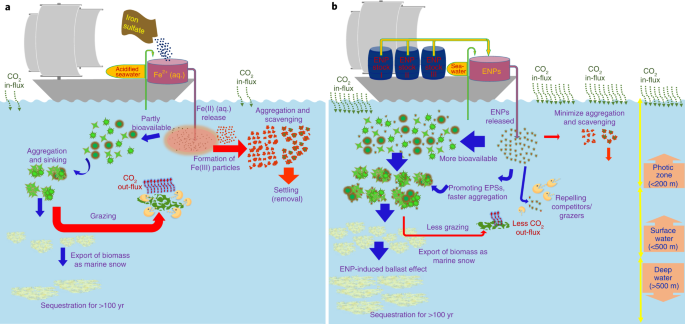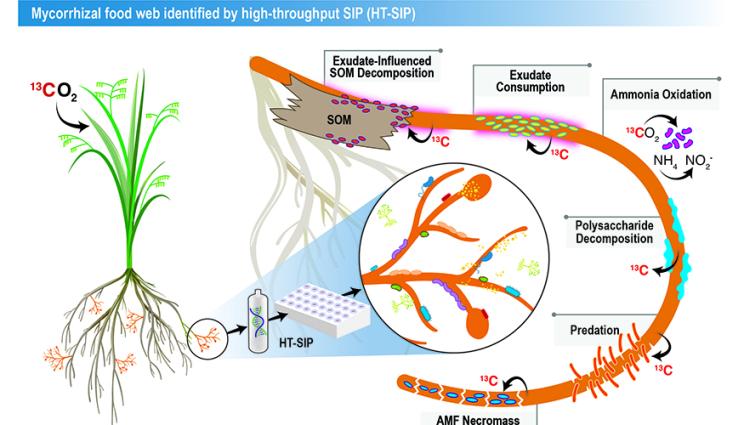鉄系肥料をナノ粒子に加工し、余分な二酸化炭素を海に貯留することに成功(Iron-based fertilizer, engineered into nanoparticles, could help store excess carbon dioxide in the ocean)
2022-11-29 パシフィック・ノースウェスト国立研究所(PNNL)
自然界では、陸からの栄養分は川や吹き溜まりを通って海に到達し、プランクトンの肥料となる。研究チームは、この自然のプロセスをさらに一歩進めて、海を通して過剰なCO2を除去することを提案している。研究チームは、慎重に設計された材料を特定の組み合わせで加えることで、海洋を効果的に肥沃化し、植物プランクトンが炭素吸収源として機能することを示唆する証拠を研究した。植物プランクトンは大量に炭素を取り込みます。そして、植物が死ぬと、余分な炭素を吸収して海の奥深くに沈んでいく。この肥料は、すでに何千年にもわたって大気から炭素を安全に隔離している自然のプロセスであるという。
研究者らは、人工ナノ粒子は表面コーティングにより、粒子がプランクトンに付着しやすくなる。また、一部の粒子は光を吸収する性質があり、プランクトンがより多くのCO2を消費・利用できるようにすることもできる。また、この一般的なアプローチを、特定の海洋環境のニーズに合わせて調整することもできる。と研究チームは述べている。
研究者らは、これまでに発表された123件の研究を分析した結果、多数の無毒な金属-酸素材料がプランクトンの成長を安全に促進することがわかった。これらの材料は安定性が高く、地球上に豊富に存在し、作りやすいため、プランクトン肥料として実行可能な選択肢であると、研究チームは主張している。
研究チームはまた、さまざまな粒子を作り出し、配布するためのコストも分析した。このプロセスは、非エンジニアリング材料を加えるよりもかなり高価になるが、効果もかなり高くなるという。
研究チームには、Hochellaのほか、イギリス、タイ、および米国にある複数の研究機関の研究者が参加した。この研究は、欧州連合の「Horizon 2020」研究革新プログラムの下、欧州研究評議会の支援を受けて行われた。
<関連情報>
- https://www.pnnl.gov/news-media/fertilizing-ocean-store-carbon-dioxide
- https://www.nature.com/articles/s41565-022-01226-w
大気中の二酸化炭素を大規模に除去するための海洋肥沃化における人工ナノ粒子の利用可能性。 Potential use of engineered nanoparticles in ocean fertilization for large-scale atmospheric carbon dioxide removal
Peyman Babakhani, Tanapon Phenrat, Mohammed Baalousha, Kullapa Soratana, Caroline L. Peacock, Benjamin S. Twining & Michael F. Hochella Jr.
Nature Nanotechnology (2022) Published: 28 November 2022

Abstract
Artificial ocean fertilization (AOF) aims to safely stimulate phytoplankton growth in the ocean and enhance carbon sequestration. AOF carbon sequestration efficiency appears lower than natural ocean fertilization processes due mainly to the low bioavailability of added nutrients, along with low export rates of AOF-produced biomass to the deep ocean. Here we explore the potential application of engineered nanoparticles (ENPs) to overcome these issues. Data from 123 studies show that some ENPs may enhance phytoplankton growth at concentrations below those likely to be toxic in marine ecosystems. ENPs may also increase bloom lifetime, boost phytoplankton aggregation and carbon export, and address secondary limiting factors in AOF. Life-cycle assessment and cost analyses suggest that net CO2 capture is possible for iron, SiO2 and Al2O3 ENPs with costs of 2–5 times that of conventional AOF, whereas boosting AOF efficiency by ENPs should substantially enhance net CO2 capture and reduce these costs. Therefore, ENP-based AOF can be an important component of the mitigation strategy to limit global warming.


